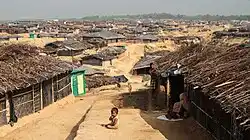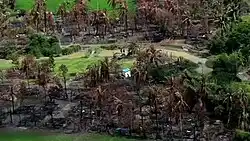
The Rohingya Genocide is an ongoing effort by the government of Myanmar to mass murder the Rohingya minority that live primarily in Rakhine State, a province lying along the coastal regions of Myanmar. The Rohingya have been persecuted for decades in Myanmar, especially since the 1970s. However, a clear policy of genocide emerged in 2016, leading to a pronounced crisis into 2017. At least 25,000 Rohingya were killed by the Myanmar military forces by the end of that year, while tens of thousands more were subjected to sexual violence, torture and other atrocities. The numbers would have been much worse had there not been a mass exodus from Rakhine State over the northern border into Bangladesh. Upwards of three-quarters of a million Rohingya fled the country, leading to the development of the world’s largest refugee camp, the Kutupalong refugee camp, which lies just over the border in the far south-eastern corner of Bangladesh.[1]
Research your ancestors on MyHeritage
Rohingya Genocide chronology of eventsRohingya Genocide chronology of events
The Rohingya people have inhabited the Burma region for several millennia. They concentrated in particularly large numbers centuries ago in Arakan, the coastal region on the eastern side of the Bay of Bengal. This coastal position meant that they were one of the first groups in Southeast Asia that came into contact with Islamic missionaries in the ninth and tenth centuries and converted soon thereafter. Their position as an Islamic group within a predominantly Buddhist Myanmar has been one of the major causes of their persecution in modern times. As early as the seventeenth century, the Rohingya were experiencing persecution on account of their position on the frontiers of the Muslim world in Southeast Asia. When British rule was firmly established in Bengal in the second half of the eighteenth century many Rohingya migrated there and those who remained welcomed the expansion of British rule south-eastwards into Burma in the nineteenth century.[2]
The Rohingya experienced a better situation under British imperial rule in Burma, but the occupation of the region by the Japanese during the Second World War led to inter-communal violence, indicating that tensions between the Rohingya and other groups in Burma had not disappeared. Burma gained independence in 1948. Since a coup in 1962 it has largely been under the control of the military, with some extended periods of liberalization and a move towards more democratic politics. Under the influence of the military junta, the government’s approach towards the Rohingya became more confrontational in the 1970s. For instance, under Operation Dragon King in 1978 the junta expelled hundreds of thousands of Rohingya to Bangladesh, though many later returned. In 1982 the Rohingya were disenfranchised under a restrictive citizenship law. A further refugee crisis occurred following bouts of repression in the early 1990s. Thus, atrocities against and persecution of the Rohingya of Rakhine State is nothing new in Myanmar.[3]

What was unusual about what began in 2016 was the severity of it. Communal rioting had broken out in parts of Rakhine State amongst the Rohingya in 2012 owing to the decades of persecution. Tens of thousands of Rohingya were forced into what were effectively concentration camps thereafter. By 2015 international observers were warning of an imminent genocide. This is exactly what happened when in the autumn of 2016 indiscriminate attacks on Rohingya in Rakhine State commenced. This continued into 2017. Then, military operations started in August 2017 to clear entire towns and villages. Through that month and into September tens of thousands of Rohingya were attacked and either murdered, wounded or detained, with many men tortured afterwards and some 18,000 women reportedly subjected to sexual violence. Settlements were bulldozed or burned to the ground as the junta sought to ethnically cleanse Rakhine State. As this occurred, hundreds of thousands of Rohingya fled over the border to Bangladesh.[4]
While the worst phase of the Rohingya Genocide occurred in the autumn of 2017 and culminated in the mass exodus over the border to Bangladesh, some 600,000 Rohingya remained in Rakhine State and are now trapped there. While the atrocities of 2017 were toned down thereafter, the government of Myanmar continues to persecute the Rohingya by restricting supplies of food, water and medicine into Rakhine State. Families have been broken up by recruiting men into the junta’s military forces, while camps for internally displaced Rohingya have left people trapped in poor conditions for years.[5] Reports in 2024 indicate that the government of Myanmar is re-escalating its violent approach to the remaining Rohingya people in Rakhine State, with random attacks on Rohingya people there that echo the incremental violence of the mid-2010s that eventually expanded into a campaign of genocide in 2016 and 2017.[6]
Extent of migration during the Rohingya GenocideExtent of migration during the Rohingya Genocide
The commencement of the policy of genocide in Myanmar in 2016 and the violence which ensued over the next months into 2017 led to the flight of hundreds of thousands of Rohingya from Rakhine State over the border to south-eastern Bangladesh. In some instances this literally occurred as units of the government of Myanmar pursued the Rohingya. An estimated three-quarter of a million Rohingya fled the country in this way. Once in Bangladesh the vast majority of these refugees settled what became known as the Kutupalong refugee camp, the largest refugee camp in the world. Over 600,000 people have lived her for the last seven years, while 50,000 people live in the nearby Jamtoli camp and several additional satellite camps to the south of Kutupalong. Owing to ongoing migration in the interim, there are now nearly one million Rohingya in these camps.[7]
Demographic impact of the Rohingya GenocideDemographic impact of the Rohingya Genocide
The Rohingya Genocide led to the deaths of at least 25,000 people in Rakhine State in 2016 and 2017 and perhaps as many as 45,000. Exact figures are unclear, as the junta remains in power in Myanmar and international groups have had to rely on estimates of death figures. Thousands of deaths have occurred since, either in Rakhine State or as a result of the poor conditions in Kutupalong refugee camp. Beyond this the main demographic impact has been to lead to the exodus of more than half the Rohingya population from Myanmar over the border to Bangladesh. The situation remains unresolved, though worryingly the Bangladeshi government has entertained extended discussions with the government of Myanmar concerning the return of the Rohingya to the country.[8]
See alsoSee also
Explore more about the Rohingya GenocideExplore more about the Rohingya Genocide
- Myanmar: Genocide of the Rohingya at World Without Genocide
- The Rohingya Crisis at The Council on Foreign Relations
- Myanmar: No Justice, No Freedom for Rohingya 5 Years On at Human Rights Watch
- Genocide, Crimes Against Humanity and Ethnic Cleansing of Rohingya at The US Department of State
References
- ↑ https://www.cfr.org/backgrounder/rohingya-crisis
- ↑ J. Sarwar Minar and Abdul Halim, ‘The Rohingyas of Rakhine State: Social Evolution and History in the Light of Ethnic Nationalism’, in Social Evolution and History, Vol. 19, No. 2 (2021).
- ↑ Jacques P. Leider, ‘History and Victimhood: Engaging with Rohingya Issues’, in Insight Turkey, Vol. 20, No. 1 (Winter 2018), pp. 99–118.
- ↑ https://www.cfr.org/backgrounder/rohingya-crisis
- ↑ https://www.bbc.co.uk/news/world-asia-68730994
- ↑ https://www.ohchr.org/en/press-releases/2024/08/seven-years-after-genocidal-attacks-world-must-act-stop-new-atrocities
- ↑ https://www.bbc.co.uk/news/world-asia-41566561
- ↑ https://www.unhcr.org/uk/news/press-releases/unhcr-statement-bangladesh-myanmar-bilateral-pilot-project-rohingya-returns

